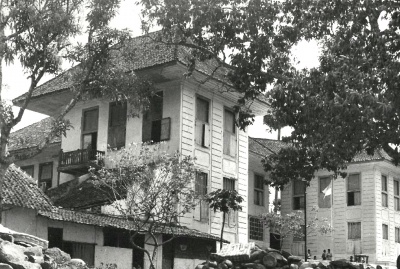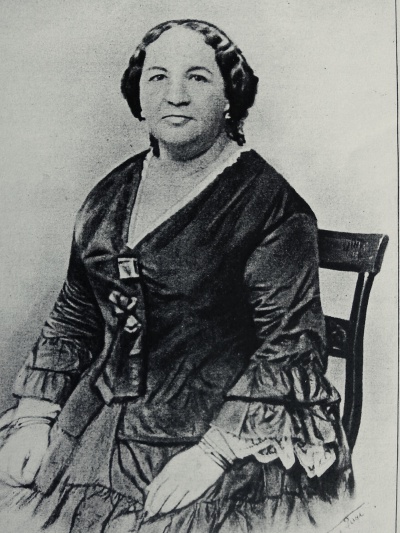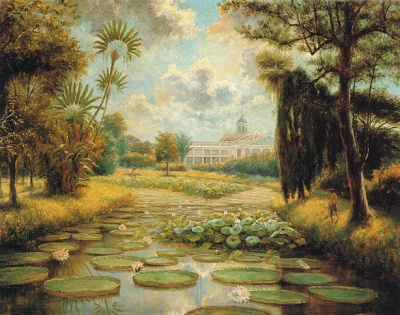Landgoed Groeneveld
| Zie gerelateerde pagina's in Categorie Familie Craan |

Jacobus Johannes Craan koopt in 1763 een villa in Batavia met uitgebreide percelen grond er omheen die het landgoed Groeneveld heet.
Inhoud |
Geschiedenis in het kort
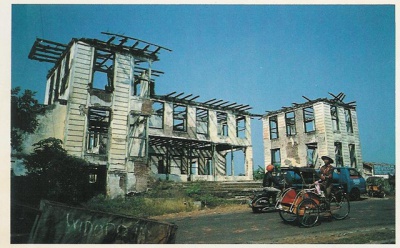
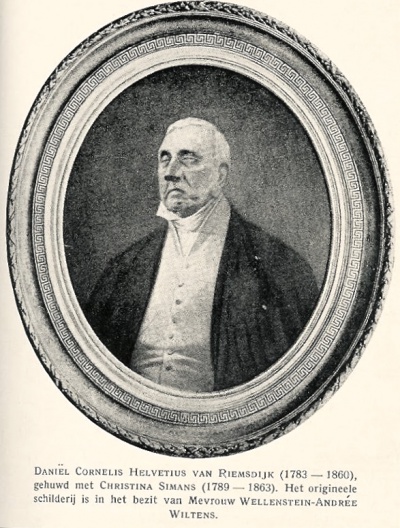
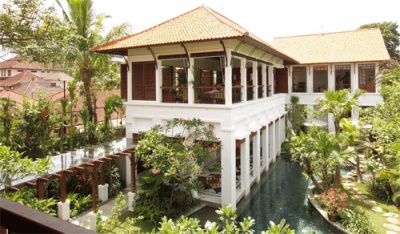
Pieter van de Velde, lid van de Raad van Indië, de hoogste Indische regering, laat een villa bouwen in 1756 op een stuk grond aan de rand van de rivier de Ciliwung in Tanjung Oost.
De eerste eigenaren genieten maar kort van hun bezitting.
Na het overlijden van Van de Velde in 1759 en de volgende koper Adriaan Jubbels in 1763, worden het gebouw en de uitgebreide percelen grond er omheen verkocht aan Jacobus Johannes Craan, die het landgoed de naam Groeneveld geeft.
Jacobus Johannes Craan renoveert het gebouw en laat ornamenten aanbrengen in houtsnijwerk boven ramen en deuren.
Na de dood van Craan in 1780 gaat het eigendom over naar zijn dochter Catharina Margaretha Craan, getrouwd met Willem Vincent Helvetius van Riemsdijk, de suikerkoning genoemd vanwege zijn uitgestrekte suikerrietplantages. De bezitting blijft in handen van opeenvolgende telgen van de familie van Riemsdijk. Deze familie baadt in overdadige luxe, runt een eigen rechtbank en een vloot. Het gebouw is een centrum van handel en koloniale macht.
Het twee verdiepingen tellende gebouw was een mix van Europese en Indonesische stijl. Deuren van kamers waren versierd met houtsnijwerk van teakhout met plantenmotieven; boven de hoofdingang prijkte een kraanvogel, symbool van de familie Craan.
In de Tweede Wereldoorlog gebruikten de Japanse overheersers het gebouw als opslagplaats. Na de bevrijding en de opeenvolgende periodes van Militaire Agressie door de Nederlanders volgen gebruikers elkaar in rap tempo op; het leger, de Barisan Pioneers, de NICA. De laatste bestemmingen van Huize Groeneveld zijn een hotel en een bedrijfspand, totdat in mei 1985 het gebouw in vlammen opgaat als gevolg van een explosie in de keuken.
A beautiful Dutch villa in ruins
Voordat het in 1985 verging werd huize Groeneveld beschouwd als een van de mooiste koloniale woningen in Jakarta. het landgoed en het rijke koloniale leven in de 18e en 19e eeuw wordt beschreven in de Jakarta Post, hieronder overgenomen.
Jakarta, Jan. 26 2008
The population was sparse. The eastern countryside was dotted with big, beautiful European villas standing on lush green fields.
The mansions in the eastern outskirts of Batavia belonged to Dutch colonial masters who had a taste for high-class comfort. It is difficult to even imagine such an environ existing now in Jakarta, where people fight for every inch of space. In fact, if Jakartans had realized the importance of preserving historical buildings, people would have had the chance to see the heritage.
The beauty of the villas were well known. Visitors to the city centuries ago extolled the Dutch villas built outside the old city of Batavia (present downtown Kota).
Most of the landhuis, as the Dutch called the villas, are now neglected. Many of them are in ruins like the Tandjong Oost mansion on Jl. Gedong in East Jakarta, right at the T-junction of Jl. Condet Raya.
Once regarded as the most beautiful villa in Batavia, it caught fire in 1985 and it is just a heap of rubble now. The inside is dirty. Chicken coops are all over the place. Living in humble houses around the ruined villa are families of officers of the Tanjung Timur police precinct.
Catching fire
Local residents say the famous villa caught fire when a stove, belonging to the occupants of the neglected building, exploded.
The Tandjong Oost mansion (which literally means the East Cape) located at the present Tanjung Timur area in East Jakarta, was so named because it was built on the east side of the cape of the Ciliwung river. Its main building had annexes on its left and right, connected only by a broad roof. At that time, it was located far from the main road to Bogor but was visible from the road.
The mansion was originally called Groeneveld (Green Field) after the surrounding green fields but another theory has it that it was named after Clasina Helena Coop a Groen, wife of the estate's first owner Pieter van den Velde.
During the era of VOC (Vereenigde Oost-Indische Compagnie, the Dutch trading company which built Batavia), Tandjong Oost was located far from the city centre. Dutch writer V.I. van den Wall described in his book, Batavia's het Huis Groeneveld of Tanjung Oost (Batavia's Groeneveld House of Tandjong Oost) that to reach the area one needed about two hours of walk from Meester Cornelis (the present Jatinegara in East Jakarta).
It was not surprising that the rich built mansions at remote areas in the18th century because life in Batavia was becoming unhealthy. Therefore the well-to-do built country houses on huge properties on the city outskirts, safe from animals, gangs of runaway slaves or the Dutch's enemies like the Mataram and Banten indigenous kingdoms.
Rich people first moved to present Jl. Pangeran Jayakarta and Ancol not far from the Kota area, later to Jl. Gunung Sahari and Jl. Hayam Wuruk and Jl. Gajah Mada--formerly called Molenvliet. Then people moved further to the south, even to Greater Jakarta area of Bogor (Buitenzorg) in West Java, where the houses sometime looked like palaces.
An English traveller noted in 1765:
|
Unique architecture
The villas had unique architectural styles as they were a combination of Dutch, Chinese and local architecture. Van den Wall described Groeneveld as having an ancient Dutch style.
Van den Velde, a government official, built the two-story mansion after buying several plots of land from Ni Hoe Kong, the exiled Chinese captain during the notorious Chinese massacre in the old city in the 1740s, and from the Sundanese regent from Cianjur, Aria Wiratanoe Datar, in 1742. The owner started to build his big mansion in 1756. It consisted of three separate buildings with the two annexes for guests.
The building's most interesting part was its central window, which was described by van den Wall in 1932 as most amazing with its rich ornaments. There was also an ornamental silver shield with the carving of a crane (bird) inside, which was the symbol of the Craan family who once owned the estate. Van den Wall:
|
In the course of time, rooms were added at the rear end of the mansion for female children to stay after their marriage. Within the complex were also cannons, which were fired to honour governor-generals passing through on their way to Bogor (Buitenzorg).
Life in the hinterlands was made lively with events like sail boat racing when all of landlords would gather. The estate's ownership changed many times after the death of van den Velde in 1759, not long after the building's construction.
The property was first sold to Adriaan Jubbels. After Jubbels death in 1763, the mansion was bought by Jacobus Johannes Craan. Craan, the first secretary of the Batavian Society of Arts and Sciences, improved the building and added the carvings to the doors.
van Riemsdijk
Through the marriage of one of Craan's daughters, the house passed to Willem Vincent Helvetius van Riemsdijk, a usurer sugar baron and also the son of Jeremias van Riemsdijk who was governor general between 1775 and 1777.
Vincent became the biggest estate owner in Batavia but he did not take much care of the lands he acquired. He became rich through the tribute he demanded from the native regents of western Java but he went too far and was finally dismissed from government office for mismanagement.
Vincent had 14 children by his wife Catharina Craan and another 12 from his six servants. Children borne from the servants had reversed family name: Kijdsmeir.
A totally different personality was his son Daniel Cornelis Helvetius van Riemsdijk, who really lived in this estate and rarely visited Batavia. He was a good farmer and administered the estate well. At that time, 6,000 cows grazed Tanjung Timur, which became a renowned dairy farm in the 1830s. Daniel van Riemsdijk spoke better Malay than Dutch.
He had three daughters by a Malay woman called Mea. Through their oldest daughter Dina, the house passed on to the family of her husband Ament.
After World War II
It remained in his possession until World War II changed everything.
The building gained historical significance during the Indonesian independence struggle when it became the headquarters of Barisan Pelopor, an underground movement against the Japanese occupation (1942-1945), which was led by Sukarno who later became the first president of the country. The group used the building between 1945 and 1946 to discuss their plans and strategies against the Japanese troops who had been using the estate as a warehouse.
After the first Dutch aggression in 1947 and the second aggression in 1948, the mansion was taken over by the NICA Dutch colonial army who turned it to a rubber plantation.
After World War II the estate was purchased by a certain Haji Sarmili who then sold it to the Jakarta Police in 1962.
